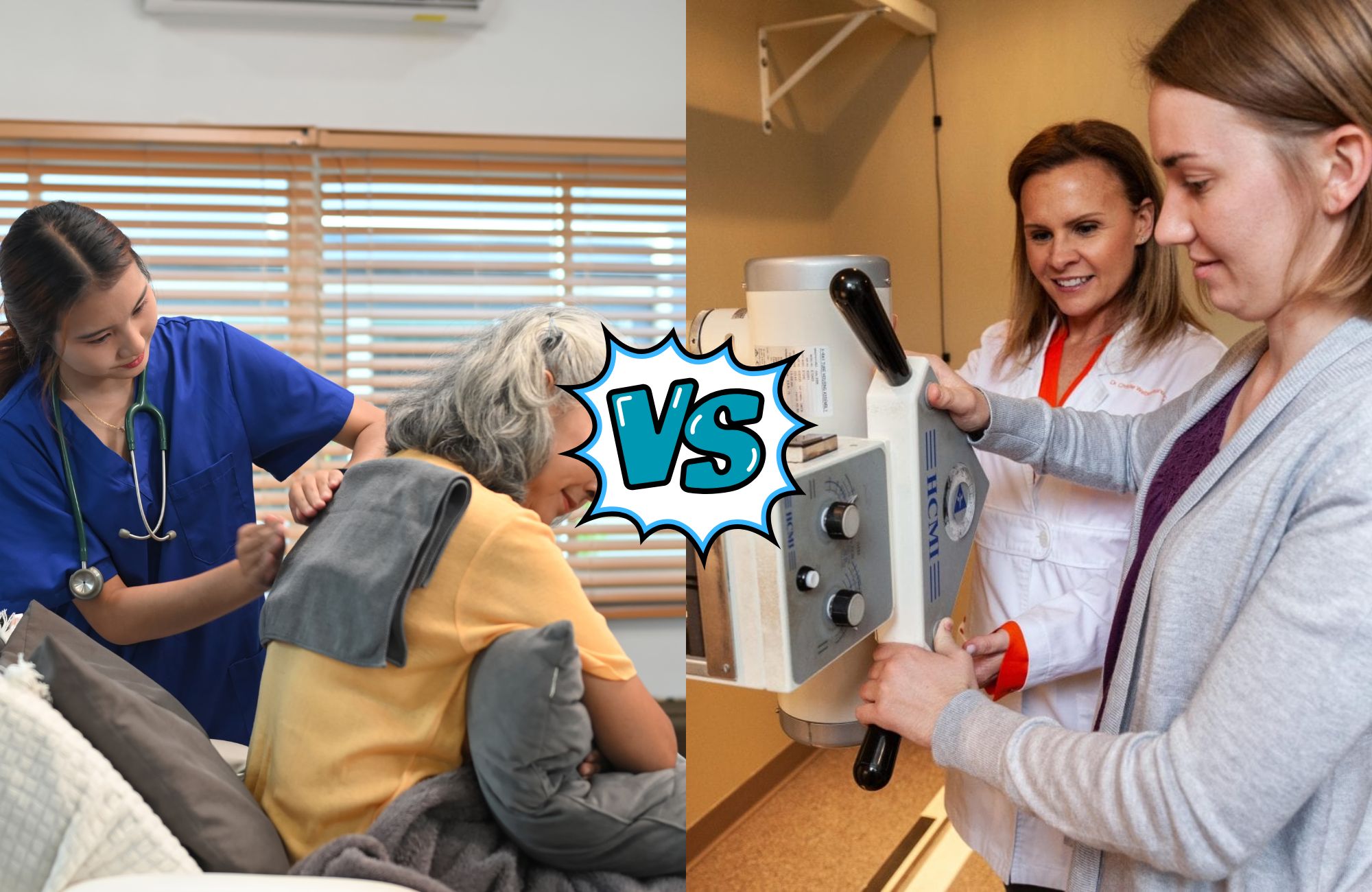


When people think about careers in respiratory care, two roles often come up for comparison: respiratory technician vs therapist. Both play an important part in helping patients with breathing problems, but they are not the same job. The difference affects responsibilities, education, pay, and career growth. If you are looking at this field, it helps to know exactly what sets these careers apart and how job placement works for each.
Respiratory therapists provide direct care for patients with breathing conditions. They do more than support other providers. They assess patients, plan treatments, and carry out advanced therapies. Typical duties include:
Therapists often work in fast-paced environments such as intensive care units and emergency rooms. They may also support patients with chronic conditions like asthma or COPD in outpatient settings.
To work as a respiratory therapist, you need at least an associate’s degree in respiratory therapy. Many therapists now earn a bachelor’s degree to improve job opportunities. Education covers anatomy, physiology, pharmacology, patient care, and clinical rotations in hospitals.
Graduates must take certification exams from the National Board for Respiratory Care (NBRC). The pathway is:
| Credential | Requirements | Role |
|---|---|---|
| CRT (Certified Respiratory Therapist) | Associate or bachelor’s degree + NBRC multiple-choice exam | Entry-level therapist |
| RRT (Registered Respiratory Therapist) | Higher passing score on the NBRC exam + clinical simulation exam | Advanced therapist, more responsibility, and higher pay |
Most states require a license to practice. Licensing usually involves passing NBRC exams and submitting an application to the state board.
According to the Bureau of Labor Statistics, respiratory therapists earn a median annual wage of about $80,450. Pay varies by experience, location, and healthcare setting. Therapists in intensive care units or specialty roles may earn more.
Job growth for respiratory therapists is strong. BLS projects faster-than-average growth because of higher rates of chronic respiratory disease and an aging population. This demand creates consistent job opportunities nationwide.
Respiratory technicians work under the supervision of a therapist or physician. Their role is to assist with treatments rather than plan them. Common responsibilities include:
Technicians often work in the same environments as therapists but have fewer independent duties.
Technicians can enter the field with a postsecondary certificate or an associate degree in respiratory care. Their training programs are shorter and focus on basic patient care and equipment support.
Certification is not always required, but some employers prefer it. Obtaining certification can improve job prospects. Without additional education, technicians usually cannot move into advanced roles.
The average annual salary for respiratory technicians is around $50,000–$73,000. This is lower than respiratory therapists because of the reduced scope of responsibility.
The job outlook for technicians is stable, but does not show the same strong growth as therapists. Many hospitals and clinics hire technicians, but more demand is centered on licensed therapists.
| Category | Respiratory Technician | Respiratory Therapist |
|---|---|---|
| Education | Certificate or associate degree | Associate or bachelor’s degree |
| Certification | Optional | Required (CRT, RRT) |
| Responsibilities | Assist with treatments, monitor patients, and maintain equipment | Patient assessment, treatment planning, ventilator management, and emergency response |
| Salary | $50,000–$73,000 annually | $80,450 annually |
| Career Growth | Limited advancement without more education | Multiple specializations and leadership opportunities |
The main differences are the level of responsibility, salary, and long-term career growth.
Looking for your next role in respiratory care? Flagstar Rehab connects qualified technicians and therapists with hospitals, rehab centers, and specialty clinics nationwide. Explore our respiratory therapist staffing opportunities here.
Employers expect both technicians and therapists to have strong clinical skills and patient care abilities. Some skills and qualities that stand out include:
For therapists, passing NBRC exams and holding RRT certification are strong hiring factors. For technicians, additional certifications can set them apart from other applicants.
Both roles can be found across many healthcare settings, including:
Therapists usually take on the more critical patients, while technicians provide support across these environments.
Respiratory technicians face limited growth unless they return to school for a therapist degree. They can gain experience but cannot independently plan treatments or lead care teams.
Respiratory therapists have clear advancement opportunities. With an RRT credential, therapists can specialize in areas such as:
Therapists may also move into leadership or education roles. The demand for skilled therapists is projected to grow as more patients need long-term respiratory support.
Whether you are just starting as a technician or advancing as a registered respiratory therapist, Flagstar Rehab can help you find the right placement. We specialize in matching healthcare professionals with positions that fit their skills and goals. Learn more about our respiratory therapist staffing solutions.
Traditionally, respiratory care professionals apply through hospital job boards or healthcare HR departments. Increasingly, many work with staffing agencies that connect them to openings in hospitals, rehab centers, long-term care, and specialty clinics.
The benefits of working with a staffing agency include:
At Flagstar Rehab, we specialize in placing respiratory therapists and technicians in healthcare settings across the country. We connect candidates with hospitals, rehab centers, long-term care facilities, and specialty programs.
Our team supports candidates during the licensing and certification process and provides ongoing career support. We offer both permanent placements and contract-to-hire opportunities, giving professionals flexibility in their careers.
Both respiratory therapists and respiratory technicians have unique advantages and challenges. Below, we outline the key points for each role.
Respiratory Therapist
Respiratory Technician
Respiratory technicians and respiratory therapists both support patients with breathing conditions, but the choice between the two comes down to education, salary, and career growth. Technicians can enter the field quickly with a certificate or associate degree, while therapists complete more advanced training and certification to take on greater responsibility and earn higher pay. Both roles are in demand, and staffing support can make it easier to connect with the right opportunities.
If you are looking for the right job in respiratory care, Flagstar Rehab can help. We connect qualified professionals with positions nationwide and provide support through every step of the placement process. Ready to take the next step? Contact us to learn more about respiratory therapist and technician job opportunities.
A respiratory therapist is licensed to assess patients, create treatment plans, and perform advanced procedures such as ventilator management and intubation support. A respiratory technician, also called a respiratory therapy technician, works under supervision. Technicians assist by administering oxygen, running basic lung function tests, and maintaining equipment, but do not create treatment plans.
Respiratory care is the broader field that includes all services provided to patients with breathing problems. It covers diagnostic testing, patient education, acute care, and long-term management. Respiratory therapy is the practice carried out by licensed professionals, such as respiratory therapists, who provide direct treatment and manage complex respiratory conditions.
The Registered Respiratory Therapist (RRT) credential is higher than the Certified Respiratory Therapist (CRT). Both are awarded by the National Board for Respiratory Care (NBRC). The CRT is the entry-level credential, while the RRT requires a higher passing score and completion of a clinical simulation exam. RRTs typically have more responsibility and higher earning potential.
No. An RRT is a Registered Respiratory Therapist who has passed the NBRC exams and is licensed to practice. An RCP, or Respiratory Care Practitioner, is a general title used in some states to describe licensed respiratory professionals, which may include RRTs. In many regions, the terms overlap, but RRT refers specifically to the credential, while RCP is a broader designation.